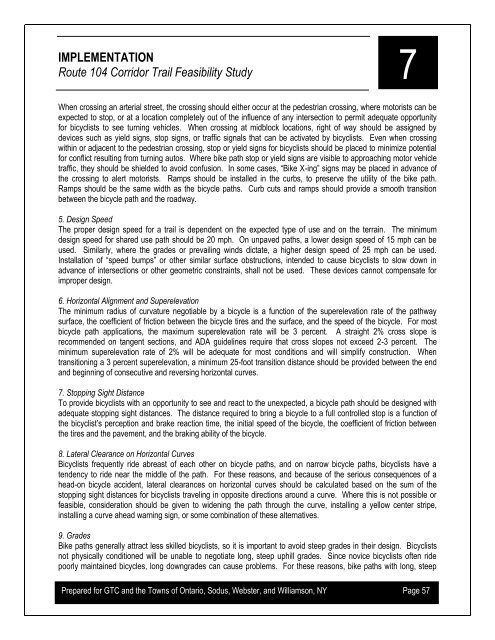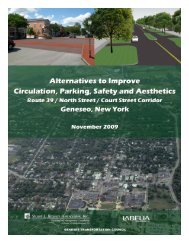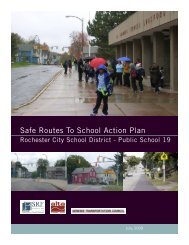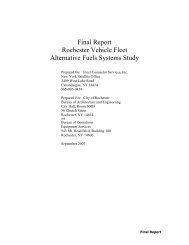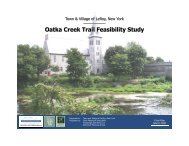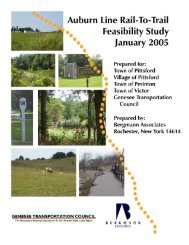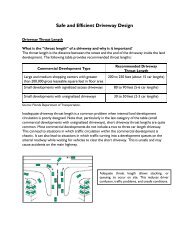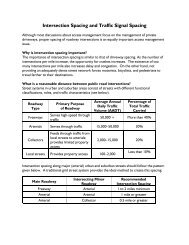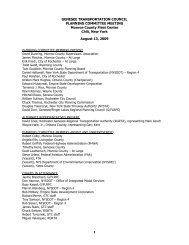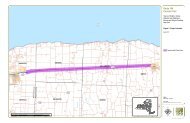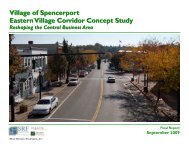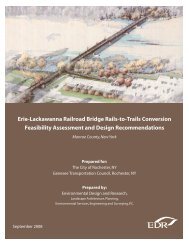Route 104 Corridor Trail Feasibility Study - Genesee Transportation ...
Route 104 Corridor Trail Feasibility Study - Genesee Transportation ...
Route 104 Corridor Trail Feasibility Study - Genesee Transportation ...
You also want an ePaper? Increase the reach of your titles
YUMPU automatically turns print PDFs into web optimized ePapers that Google loves.
IMPLEMENTATION<br />
7<br />
<strong>Route</strong> <strong>104</strong> <strong>Corridor</strong> <strong>Trail</strong> <strong>Feasibility</strong> <strong>Study</strong><br />
When crossing an arterial street, the crossing should either occur at the pedestrian crossing, where motorists can be<br />
expected to stop, or at a location completely out of the influence of any intersection to permit adequate opportunity<br />
for bicyclists to see turning vehicles. When crossing at midblock locations, right of way should be assigned by<br />
devices such as yield signs, stop signs, or traffic signals that can be activated by bicyclists. Even when crossing<br />
within or adjacent to the pedestrian crossing, stop or yield signs for bicyclists should be placed to minimize potential<br />
for conflict resulting from turning autos. Where bike path stop or yield signs are visible to approaching motor vehicle<br />
traffic, they should be shielded to avoid confusion. In some cases, ―Bike X-ing‖ signs may be placed in advance of<br />
the crossing to alert motorists. Ramps should be installed in the curbs, to preserve the utility of the bike path.<br />
Ramps should be the same width as the bicycle paths. Curb cuts and ramps should provide a smooth transition<br />
between the bicycle path and the roadway.<br />
5. Design Speed<br />
The proper design speed for a trail is dependent on the expected type of use and on the terrain. The minimum<br />
design speed for shared use path should be 20 mph. On unpaved paths, a lower design speed of 15 mph can be<br />
used. Similarly, where the grades or prevailing winds dictate, a higher design speed of 25 mph can be used.<br />
Installation of ―speed bumps‖ or other similar surface obstructions, intended to cause bicyclists to slow down in<br />
advance of intersections or other geometric constraints, shall not be used. These devices cannot compensate for<br />
improper design.<br />
6. Horizontal Alignment and Superelevation<br />
The minimum radius of curvature negotiable by a bicycle is a function of the superelevation rate of the pathway<br />
surface, the coefficient of friction between the bicycle tires and the surface, and the speed of the bicycle. For most<br />
bicycle path applications, the maximum superelevation rate will be 3 percent. A straight 2% cross slope is<br />
recommended on tangent sections, and ADA guidelines require that cross slopes not exceed 2-3 percent. The<br />
minimum superelevation rate of 2% will be adequate for most conditions and will simplify construction. When<br />
transitioning a 3 percent superelevation, a minimum 25-foot transition distance should be provided between the end<br />
and beginning of consecutive and reversing horizontal curves.<br />
7. Stopping Sight Distance<br />
To provide bicyclists with an opportunity to see and react to the unexpected, a bicycle path should be designed with<br />
adequate stopping sight distances. The distance required to bring a bicycle to a full controlled stop is a function of<br />
the bicyclist‘s perception and brake reaction time, the initial speed of the bicycle, the coefficient of friction between<br />
the tires and the pavement, and the braking ability of the bicycle.<br />
8. Lateral Clearance on Horizontal Curves<br />
Bicyclists frequently ride abreast of each other on bicycle paths, and on narrow bicycle paths, bicyclists have a<br />
tendency to ride near the middle of the path. For these reasons, and because of the serious consequences of a<br />
head-on bicycle accident, lateral clearances on horizontal curves should be calculated based on the sum of the<br />
stopping sight distances for bicyclists traveling in opposite directions around a curve. Where this is not possible or<br />
feasible, consideration should be given to widening the path through the curve, installing a yellow center stripe,<br />
installing a curve ahead warning sign, or some combination of these alternatives.<br />
9. Grades<br />
Bike paths generally attract less skilled bicyclists, so it is important to avoid steep grades in their design. Bicyclists<br />
not physically conditioned will be unable to negotiate long, steep uphill grades. Since novice bicyclists often ride<br />
poorly maintained bicycles, long downgrades can cause problems. For these reasons, bike paths with long, steep<br />
Prepared for GTC and the Towns of Ontario, Sodus, Webster, and Williamson, NY Page 57


